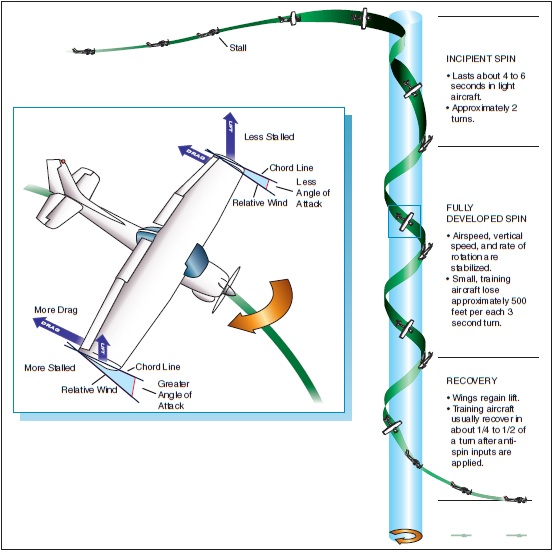
Chapter 4—Slow Flight, Stalls, and Spins
Table of Contents
Introduction
Slow Flight
Flight at Less than Cruise Airspeeds
Flight at Minimum Controllable Airspeed
Stalls
Recognition of Stalls
Fundamentals of Stall Recovery
Use of Ailerons/Rudder in Stall Recovery
Stall Characteristics
Approaches to Stalls (Imminent Stalls)—Power-On or Power-Off
Full Stalls Power-Off
Full Stalls Power-On
Secondary Stall
Accelerated Stalls
Cross-Control Stall
Elevator Trim Stall
Spins
Spin Procedures
Entry Phase
Incipient Phase
Developed Phase
Recovery Phase
Intentional Spins
Weight and Balance Requirements

SPIN PROCEDURES
The flight instructor should demonstrate spins in those airplanes that are approved for spins. Special spin procedures or techniques required for a particular airplane are not presented here. Before beginning any spin operations, the following items should be reviewed.
- The airplane’s AFM/POH limitations section, placards, or type certification data, to determine if the airplane is approved for spins.
- Weight and balance limitations.
- Recommended entry and recovery procedures.
- The requirements for parachutes. It would be appropriate to review a current Title 14 of the Code of Federal Regulations (14 CFR) part 91 for the latest parachute requirements.
A thorough airplane preflight should be accomplished with special emphasis on excess or loose items that may affect the weight, center of gravity, and controllability of the airplane. Slack or loose control cables (particularly rudder and elevator) could prevent full anti-spin control deflections and delay or preclude recovery in some airplanes.
Prior to beginning spin training, the flight area, above and below the airplane, must be clear of other air traffic. This may be accomplished while slowing the airplane for the spin entry. All spin training should be initiated at an altitude high enough for a completed recovery at or above 1,500 feet AGL.
It may be appropriate to introduce spin training by first practicing both power-on and power-off stalls, in a clean configuration. This practice would be used to familiarize the student with the airplane’s specific stall and recovery characteristics. Care should be taken with the handling of the power (throttle) in entries and during spins. Carburetor heat should be applied according to the manufacturer’s recommendations.
There are four phases of a spin: entry, incipient, developed, and recovery. [Figure 4-10]

Figure 4-10. Spin entry and recovery.
PED Publication